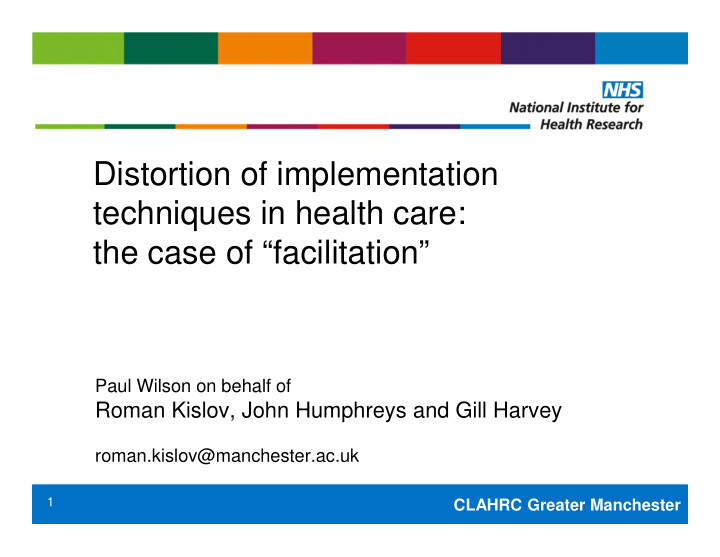



Distortion of implementation techniques in health care: the case of “facilitation” Paul Wilson on behalf of Roman Kislov, John Humphreys and Gill Harvey roman.kislov@manchester.ac.uk CLAHRC Greater Manchester 1
Context • NIHR CLAHRC Greater Manchester is a partnership between health providers and commissioners and academics to improve the health of people in Greater Manchester and beyond through carrying out research and putting it into practice. • Work with healthcare staff to design a project to address known underperformance against Quality and Outcomes Framework indicators for CKD. –Halve the gap between recorded and estimated prevalence on practice registers –75% of CKD patients to be tested for proteinuria and managed to NICE recommended blood pressure targets CLAHRC Greater Manchester CLAHRC Greater Manchester 2 2
Why facilitation? • CLAHRC GM implementation approach – Framed by Promoting Action of Research Implementation in Health Services (PARIHS) conceptual framework and the Model for Improvement • PARIHS defines successful implementation as a function of the interplay between Evidence, Context and Facilitation: SI = f (E,C,F) • Facilitation: – A role (facilitator) + a process (facilitation) Improvement methods: Aims/goals Collaborative learning Local application (PDSA) Audit and feedback Benchmarking CLAHRC Greater Manchester CLAHRC Greater Manchester 3 3
CKD Improvement Project • Internal facilitators (non-clinical and clinical) • External support – experienced facilitators – clinical/opinion leaders – academic guidance • Changes in facilitation input and support over time CLAHRC Greater Manchester CLAHRC Greater Manchester 4 4
Project phases • 1 non- PHASE 1 PHASE 2 PHASE 3 • 2 non- • 2 non- clinical clinical clinical facilitator facilitators facilitators • 2 clinical • Programme • 3 clinical facilitators Manager facilitators • 2 managers • Data analyst • 3 managers • Data analyst • Clinical • Data analyst • Clinical leader • [All part- leader • Academic/ time] • Academic/ experienced experienced facilitator facilitator CLAHRC Greater Manchester CLAHRC Greater Manchester 5 5
How did facilitation evolve? Three interrelated and overlapping processes: 1. Prioritisation of (measurable) outcomes over (interactive) process; 2. Reduction of (multiprofessional) team engagement; 3. Erosion of the designated facilitator role CLAHRC Greater Manchester CLAHRC Greater Manchester 6 6
Facilitation as a managerial technique ‘Soft core’ Enabling Involvement the learning of teams processes The Articulated facilitator goals role ‘Hard periphery’ Tools CLAHRC Greater Manchester CLAHRC Greater Manchester 7 7
Distortion of facilitation • Explicit performance • Privileging goals some ‘core’ Involvement prioritised components of teams over implicit over the sustainability- others related goals Articulated • Replacing • Learning ‘core’ goals how to meet components Enabling performance by the the learning targets, ‘peripheral processes rather than ones Tools how to improve • Facilitators services shifting from The ‘enabling’ to • Context facilitator ‘managing’ substantially limits role and ‘doing’ the agency of facilitators CLAHRC Greater Manchester CLAHRC Greater Manchester 8 8
Implications for practice • Revisiting the facilitation concept – from individuals in facilitator roles to network of facilitators and facilitator development and support – differentiating facilitator role and scope according to context • Revisiting the PARIHS framework – from heuristic to integrated-PARIHS framework – explicit theoretical base – facilitation as the active element – operationalising the facilitation role and process CLAHRC Greater Manchester CLAHRC Greater Manchester 9 9
The i-PARIHS framework Expert facilitator Experienced facilitator Novice facilitator Harvey et al. Implement Sci 2016; 11:33. CLAHRC Greater Manchester 10
Recommend
More recommend